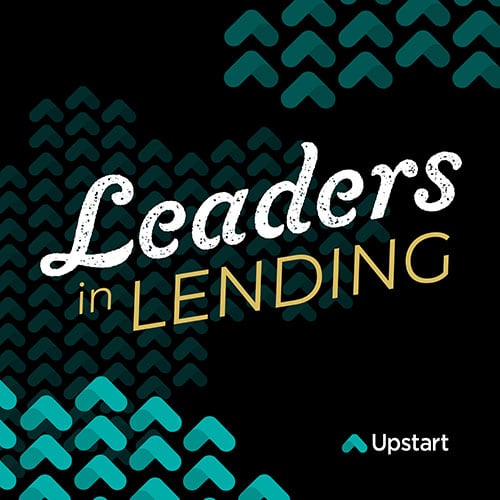Leaders in Lending | Ep. 112
The ‘Moonshot versus the Pragmatic Approach’ to Digitization
Ben Udell, SVP Client Experience at Lake Ridge Bank, is the guide to the future of banking, and how to successfully integrate helpful technologies while retaining the value of face-to-face experiences.
.png?width=200&height=200&name=Ben%20Udell-modified%20(1).png)

GUEST SPEAKER
Ben Udell

ABOUT
Lake Ridge Bank
Lake Ridge Bank aims to simplify their customers' financial lives and experience the flexibility and convenience needed from their bank for busy lifestyles. As part of the community, Lake Ridge is committed to providing each of their customers with a personalized experience focused on their needs and to make banking easy and prosperous for everyone.
Key Topics Covered
- Balancing pragmatic and moonshot approaches
- How community banks can compete with enterprise banks
- Consumer credit trends, including BNPL and personal loans

“You think about the cost - we could take $10,000 the moonshot and invest it into a program that allows us to be simply more efficient with that client experience on the front end or more efficient in the branch.”


EPISODE RECAP & SUMMARY
Technology is revolutionizing the world. With continuous iterations of tools and processes, people juggle between implementing with careful consideration and jumping head-first into large-scale digital transformation projects.
How can banks pragmatically embrace these digital advancements without losing touch with in-person experiences? Ben Udell, SVP Client Experience at LakeRidge Bank, is the guide to the future of banking, and how to successfully integrate helpful technologies while retaining the value of face-to-face experiences.
Join us as we discuss:
- Balancing pragmatic and moonshot approaches
- How community banks can compete with enterprise banks
- Consumer credit trends, including BNPL and personal loans
Balancing pragmatic and moonshot approaches
How can banks measure the distance between pragmatic and moonshot innovations in digitization?
Banks juggle these questions regularly, especially with the onslaught of new tech coming into the picture. “We get so excited about all the new technology coming out, the technology available to us by providers,” Udell said. “We look for these gigantic moonshot-space-jumps with how we're operating as a business, either internally or with clients.”
However, going straight for the moonshot has costs and must have support from tech-savvy personnel for successful implementation. Not every bank can handle that severe of a change.
On the pragmatic side of the scale, banks can see manageable change — going paperless, leveraging tools like Microsoft 365, and so on — that increases efficiency. These changes are quick and have lower costs both financially and energy-wise.
That said, if banks stay strictly in pragmatic advancements, they risk falling behind. There must be a balance between high-velocity change and low-simmering improvements.
Finding the balance
“Think about how we spend our money and resources across our industry — we love that moonshot,” Udell said. “You think about the cost — we could take $10,000 of the moonshot and invest it into a program that allows us to be more efficient with client experience on the front end or more efficient in the branch, so we have time for more of our clients.”
If the moonshot has little to no return in the form of a streamlined customer and teller experience, it’s probably not the right time for the leap.
“If you're the digital player that wants to have that A+ digital-only experience, wonderful. If you want to be this high-touch, high in-person, white glove treatment, wonderful,” Udell said. “It's when we start veering away from those too far that we need to come back and find some balance with how we're operating as an organization.”
Listen to your people. Choose a focus. Do it well.
How community banks can compete with enterprise banks
A community bank may not be able to compete with the Bank of America's of the world in terms of top-shelf digital experiences and resources, but, there’s the potential to create an excellent in-person branch experience.
“We're not going to be amazing at technology. But we're also going to have this really strong commitment to clients. We have to start thinking about what that means,” Udell said.
A community bank typically has empowered representatives who can solve problems on the spot without multiple calls and round-about-procedures. With a more intentional frontend force, there is room for personal touch and familiarity. Comfort. Ease. Real voices.
“When we say we want to be a strong player in the community and be easy to work with in person, that's what that means,” Udell said. “And then, we'll build on our online and mobile to be pretty darn good, too.”
Consumer credit trends, including BNPL and personal loans
More and more consumers — particularly Millennials and Gen Z — choose to either not sign up for credit cards or, if they do hold one, rarely use it in their regular transactions.
These newer generations gravitate towards Buy Now Pay Later instead. “This is a great case of using our resources internally within our own financial institutions,” Udell said. “ I noticed that there's this lack of connection. We question, ‘Are we going to get an ROI out of it?” Maybe not today, but it's part of an overall package of developing longer-term relationships.”
Encouraging members to open credit lines may not pay off in the short term, but that is where customer education can shine and bring long-term ROI. If customers do not understand the benefits of a credit line, they will stick with what they know.
Another piece of recent credit trends comes in the form of personal loans. Many people across generations are looking for home loans and ways to become homeowners — a tricky feat in today's climate — and need guidance. This combination creates a sizable opportunity in lending.
“When you start looking at the math, there is a huge volume of personal loans every year, and you take a step back and say, ‘Well, what percentage of the population doesn't own a home?’ So they can't get home equity,” Udell said. “What percentage of the population doesn't want to use home equity? And all of a sudden, you've got this gigantic marketplace for helping people with personal loans.”
Taking steps towards building longer-term relationships and serving diverse consumer needs doesn't have to mean a moonshot. Sometimes all it takes is some additional research and attention.
Stay tuned for new episodes every week on the Leaders in Lending Podcast.




